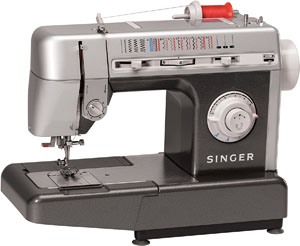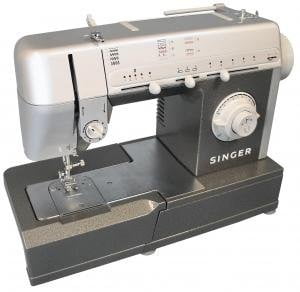If you want a sewing machine that’s both stronger and faster than the typical ones you’d buy for your home, try one of these commercial grade models from Singer. They are popular with schools and small businesses because they handle denim, upholstery, and webbing equally well. Let’s examine them both to see which one is better for your projects.
Singer CG590 Commercial Grade Sewing Machine

The Singer CG590 has a 7-segment feeding system ready to tackle tough projects with neat, even stitches. It cranks out up to 1100 stitches per minute even in thick fabrics and layers. And it has suction cup feet to keep it secure on your worktable.
Those three highlights are just a taste of all the professional-level features of the CG590. It also offers a 4-step buttonhole maker, automatic needle threader, and the ability to drop the feed for free motion sewing. There is a free arm for sewing cuffs and collars, too.
With the 18 built-in stitches that have adjustable length and width, you can create a wide variety of projects, from home decorations to garment construction to quilting. And there are several presser feet included in the box, like blind hem, satin stitch, buttonhole, zipper, and all-purpose.
While you work, you can take advantage of the adjustable tension, a thread cutter, and automatic reverse to reinforce a seam. There are also three needle positions for work like topstitching and cording. And the extra-high presser foot lifter helps you sew quilts and other thick layers.
The only downside to the Singer CG590 is that its speed is only controllable by the foot pedal. This may be challenging to novice sewers simply because the machine is so fast. But this may be partially compensated by the regulating dial that lets you adjust the foot control.
More features of the Singer CG590 sewing machine:
- Comes with a 25-year warranty on the head, 2-year warranty on the electrical system, and 90-days free labor
Singer CG-550 Commercial Grade Sewing Machine

If you compare the Singer CG590 to the CG550, you’ll see that there are minor cosmetic differences like between them. For example, the CG550 doesn’t have suction cup feet. But what you might not notice right off are the internal details that set them apart.
For one, the CG550 offers 11 built-in stitches (counting the buttonhole maker) as opposed to the CG590’s selection of 18 stitches. And two, you won’t be able to adjust the height of the feed dogs for free motion sewing.
Other than those two specifications, the two commercial grade machines are alike in speed and power. The CG550 can handle thick layers and tough fabrics while sewing up to 1100 stitches per minute. And you can use the free arm to expertly sew cuffs and collars with ease.
Next, the automatic needle threader, the top drop-in bobbin, and automatic bobbin winder make it simple to get started on your next project. While you sew, you can change the length and width of the built-in stitches. And there’s a 4-step buttonhole maker, too.
While new sewers might find the quick sewing speed intimidating, they can adjust the electronic foot pedal control to help them manage. And they may appreciate the horizontal thread mount for the spool that keeps breakage to a minimum.
Finally, the CG550 comes with an assortment of accessories that store onboard. You’ll have presser feet, needles, bobbins, and more to help you begin sewing without spending extra money.
More features of the Singer CG550 sewing machine:
- Comes with a 25-year warranty on the head, 2-year warranty on the electrical system, and 90-days free labor
Recommendation
If you plan to do basic stitching on similar projects, you might not have a preference between the Singer CG590 and the CG550. Both are fast and powerful commercial machines, putting out up to 1100 stitches a minute. And both are only controllable with their foot pedals.
But if you create diverse items, especially quilts, you’ll be better served by the Singer CG590. It offers more stitches and lets you drop the feed dog system for free motion sewing. It also has suction cup feet to hold it steady on a worktable.